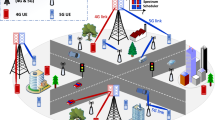Abstract
In this article, performance of sliding frame (SF) R-ALOHA protocols for real-time distributed wireless networks is investigated analytically and by simulation. First, a discrete Markov chain and Monte Carlo modeling are constructed to evaluate dynamic behavior of the protocol in transient state including distribution of the system stabilization time (SST) and the average number of successful terminals. Furthermore, a hierarchical decomposition is conducted to simplify steady state analysis, thus generating two one-dimensional Markov chains for closed-form performance of SF R-ALOHA under local wireless environment. Terminals with Poisson message arrivals and Poisson message length are analyzed. Consequently, performance indices, such as throughput, the average message delay, and packet dropping probability, are derived from the proposed analytic models. Capture effects on the SF R-ALOHA system in the presence of multipath and shadowing are also obtained by the Markov chain analysis. The numerical results from the analytic models are compared with that from simulation and equilibrium point analysis, proving correctness, accuracy, and scalability of the decomposition. The results also reveal performance characteristics of the SF R-ALOHA system.













Similar content being viewed by others
References
Zhu, J., & Roy, S. (2003). MAC for dedicated short range communications in intelligent transportation system. IEEE Communications Magazine, 41, 60–67.
Bana, S. V., & Varaiya, P. (2001). Space division (SDMA) for robust ad hoc vehicle communication networks. In IEEE International Conference on Intelligent Transportation Systems, Oakland, USA.
Katragadda, S., Murthy, G., Rao, R., Kumar, M., & Sachin, R. (2003). A decentralized location-based channel access protocol for inter-vehicle communication. In 57th IEEE Vehicular Technology Conference. Jeju, South Korea.
Borgonovo, F., Capone, A., Cesana, M., & Fratta, L. (2004). ADHOC MAC: A new MAC architecture for ad hoc networks providing efficient and reliable point-to-point and broadcast services. ACM Wireless Networks, 10(4), 359–366.
Verdone, R. (1997). Multihop R-ALOHA for inter-vehicle communications at millimeter waves. IEEE Transactions on Vehicular Technology, 46(4), 992–1005.
IEEE 802.11 (1999). Working Group, Part 11: wireless LAN medium access control (MAC) and physical layer (PHY) specifications, ANSI/IEEE Std. 802.11, Sept.
Liu, T., Silvester, J. A., & Polydoros, A. (1995). Performance evaluation of R-ALOHA in distributed packet radio networks with hard real-time communications. IEEE 45th Vehicular Technology Conference, Chicago, USA.
Barcelo, F., & Ramon, A. (1997). PRMA performance evaluation based on queueing theory. In IEEE International Conference on Personal Wireless Communications (ICPWC’97), Bombay.
Taska, S. (1983). Stability and performance of the R-ALOHA packet broadcast system. IEEE Transactions on Computers, C-32(8), 717–726.
Nanda, S., Goodman, D. J., & Timor, U. (1991). Performance of PRMA: A packet voice protocol for cellular systems. IEEE Transactions on Vehicle Technology, 40(3), 584–598.
Lam, S. S. (1980). Packet broadcast networks- a performance analysis of the R-ALOHA protocol. IEEE Trans. on Computers, C-29(7), 596–603.
Crisler, K., & Needham, M. (1995). Throughput analysis of reservation ALOHA multiple access. IEE Electronics Letters, 31(2), 87–89.
Guo, Q., & Godlewski, P. (1991). Slidng frame R-ALOHA (SFRA) protocol for microcellular systems. IEEE 41st Vehicular Technology Conference, St. Louis, USA.
Lau C. T., & Leung, C. (1992). Capture models for mobile packet radio networks. IEEE Transactions on Communications, 40, 917–925.
Trivedi, K. S. (2002). Probability and statistics with reliability, queuing and computer science applications (2nd ed.). Wiley.
Samaras, K., O’Brien, D. C., & Edwards, D. J. (2000). Analytical calculation of throughput of ALOHA based protocols in optical wireless data networks. IEE Proceedings-J Optoelectronics, 147(4), 279–280.
Qiu, X., & Li, O. K. (1996). On the capacity of packet reservation multiple access with capture in personal communication systems. IEEE Transactions on Vehicle Technology, 45(40).
Ma, X., & Refai, H. (2006). EPA analysis of sliding frame R-ALOHA for real-time ad hoc wireless networks in a fading environment. IEEE Vehicular Technology Conference, Montreal, Canada, Fall.
Acknowledgments
The authors would like to thank anonymous reviewers for their constructive comments that have significantly improved the paper quality.
Author information
Authors and Affiliations
Corresponding author
Rights and permissions
About this article
Cite this article
Ma, X., Refai, H.H. Analysis of sliding frame R-ALOHA protocol for real-time distributed wireless networks. Wireless Netw 15, 1102–1112 (2009). https://doi.org/10.1007/s11276-008-0105-6
Published:
Issue Date:
DOI: https://doi.org/10.1007/s11276-008-0105-6




